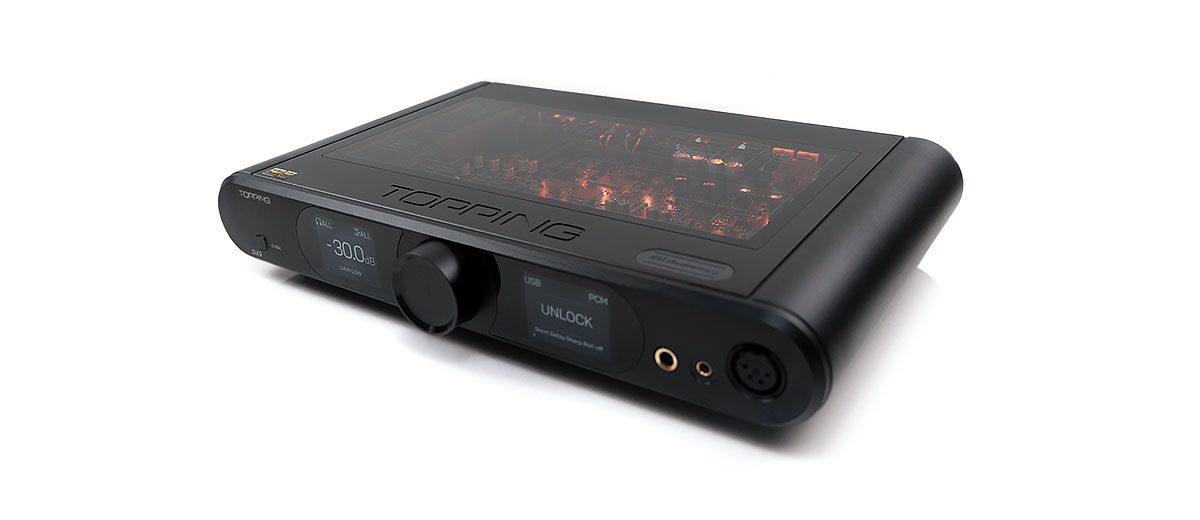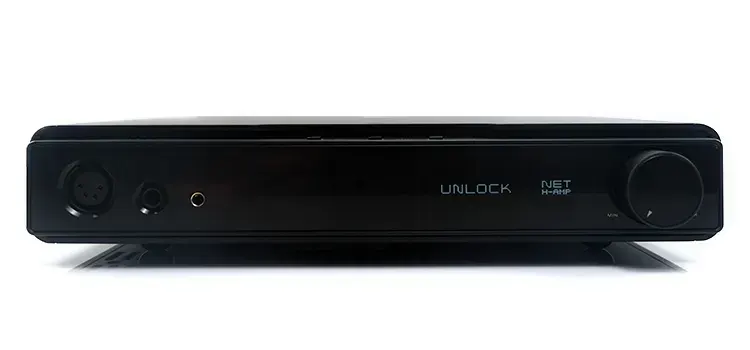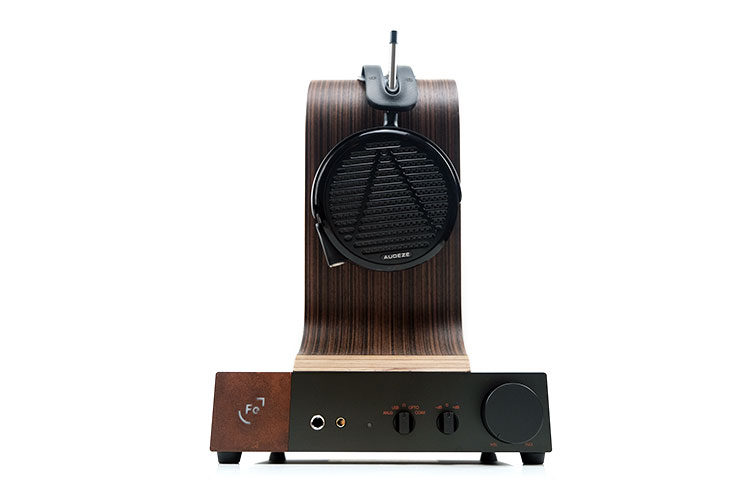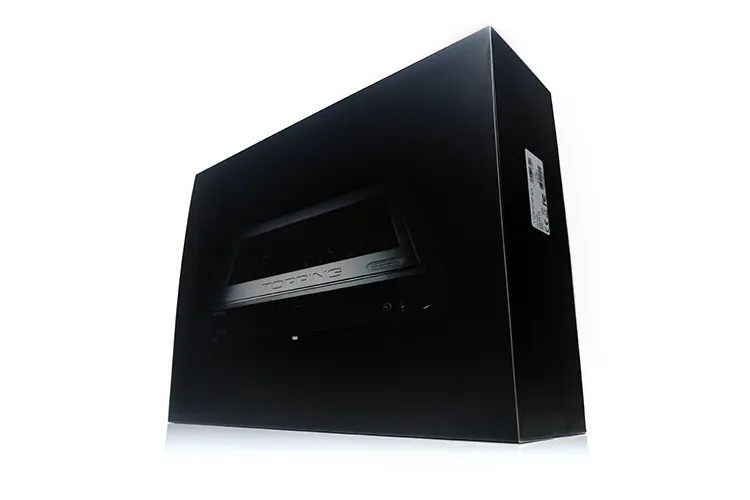Selected Comparisons
The following selected comparisons to the Topping DX9 were completed using a mix of the Austrian Audio The Composer, the ZMF Headphones Caldera Closed, and the HEDD Audio HEDDphone Two. Our focus here is on each unit’s headphone output performance.
HIFIMAN Serenade
The HIFIMAN Serenade was launched around the same time as the Prelude, both of which are collaborations with Goldenwave with the Serenade being the cheaper of the two, and closer to the DX9 price.
Technical
Much like the DX9, the Serenade is a slimline desktop-integrated DAC and amplifier with quite a bit of overlap in terms of features on a high level.
Both offer balanced and unbalanced headphone amplification to the front, as well as options for a fixed line-out or a variable volume pre-out to the rear.
The two units will accept USB-DAC, coaxial, and optical digital inputs. Both have a decoding ceiling of DSD512 and PCM 32BIT/768kHz though the Serenade will reach that limit via its RF45 socket and not USB.
However, that is where the similarities end because topology-wise, these are vastly different offerings. For a start, the Serenade uses HIFIMAN’s in-house Himalaya R-2R DAC whereas the DX9 is a classic delta-sigma with the Ak4499EQ.
The DX9 also offers wireless BT5.1 receiving with up to LDAC decoding, a feature the first-run Serenade offered but with a recently reduced price point, they removed it.
The amplification on both units is discrete-engineered, however, the DX9 is entirely in-house with 6 modules of its NFCA amplifier separately routing the SE and balanced output signals.
Headphone output power on both is good though the DX9 has an edge at 7W into a 32Ω load compared to a maximum of 4W from the equivalent load on the balanced output of the Serenade. At 300Ω the DX9 can do 1W compared to 750mW balanced from the Serenade.
The fixed line out on the Serenade is marginally higher at 2.2Vrms SE and 4.5Vrms balanced compared to 2.1Vrms and 4.4Vrms.
However, the unchanged voltage for the pre-out means the Serenade variable volume pre-out is not an independent true pre-out in the same fashion as the DX9 and is not ideal for big power amps.
Design
The Serenade is a big departure from HIFIMAN’s usual form factor. The collaboration with Goldenwave brought a new way of thinking about hi-fi unit design into the HIFIMAN family fold, one that I find a lot closer to the DX9 format than the likes of the EF600 tower.
That top panel glass finish is eye candy on the DX9. However, looking at them head-on, both are black stealthy low-profile units, perhaps more so for the slightly narrower but deeper Serenade.
I would give a nod to the DX9 for legible LED displays. I do like the Serenade one in terms of clean and easy-to-read interface but the depth of menu options for the DX9 combined with the multi-display options from its large dual LCD screens is more eye-catching.
I also find the manual control options on the DX9 a bit easier to manage with more menu labeling combined with the multifunctional dial. The Serenade system of round-robin buttons on the top panel is stealthier but more limited in what you can do beyond switch input and outputs with screen brightness levels.
The control suite of the DX9 is also backed with a remote control, which the Serenade could do with given its similar positioning as a potential hi-fi system centerpiece.
One thing to note, however, is the LAN and streaming options on the Serenade which the DX9 can only manage via BT.
That makes a big difference when hooking up to ROON and other DLNA/Airplay services. In a way, that is your Serenade remote control as there are plenty of apps you can use to feed a lossless low-jitter signal to the unit.
Performance
Comparing these two amps is a bit like discussing the merits of digital photography over film and vice versa. For some, one platform is always better than the other for various reasons, and often ardent enthusiasts are not for changing.
For instance, I could tell you the DX9 is far more resolving, delivering classic pristine ‘delta-sigma’ polish to every note, and creating a more complex ‘picture’ that would stand the test of any ‘pixel-peeping’ headphone such as the Austrian Audio Composer.
Somehow, the film enthusiast would retort that it lacks character and that the Serenade has more emotional coloration to the sound, enhanced warmth and bloom, and richer texture, particularly with female vocals.
Certainly, the Serenade’s analog vibes will create a smoother more relaxed tonal signature inducing a pleasant and euphonic listening experience with headphones such as the Composer. What it cannot offer, and what the DX9 delivers in spades, is insight and clarity.
Here, the DX9 is super tight across the spectrum with better layering and excellent clarity giving the listener much more information on the periphery and digging out a stronger sense of order through the middle with tricky mid-centric headphones such as the HEDDphone Two.
If you want speed, more explosive dynamics, and a slightly drier but more polished interpretation of music then the DX9 is the better choice. Fast-tempo audio is its best friend.
If you need something smoother, and denser on the lows with a lingering decay combined with a more euphonic timbre, particularly for vocals, then the Serenade is the logical pick.
Ferrum ERCO
The Ferrum ERCO was launched in Mid-2022 and represented the company’s first-ever integrated DAC and amplifier aimed at the headphone market. It also won our Top Gear Best Amp/DAC that same year.
Technical
Both units are compact integrated desktop DAC and headphone amplifiers with additional variable volume pre-out and fixed line-out options.
However, in a positional sense, the DX9 has more to offer power amp users with a more powerful dedicated pre-out separate from its fixed line-out. The ERCO is more of an open system for 3rd party DAC input with a single SE dual RCA analog input alongside its balanced and SE analog outputs.
The more curious omission from the ERCO is the 4-in XLR PO on the front panel with a 4.4mm pentaconn option replacing it. Arguably, a differentiator from the Ferrum OOR headphone amplifier which has a 4-pin XLR and no 4.4mm jack.
Both use delta-sigma DACs though arguably the AK4499EQ is a higher-end chipset compared to the ERCO’s ES9028PRO. Decoding on the ERCO is lower at DSD256 and PCM 32BIT/384kHz compared to the DX9’s top-level DSD512 and PCM 32BIT/768kHz.
You also have the additional wireless BT receiver on the DX9 with up to LDAC, a feature Ferrum left out of the ERCO. Instead, Ferrum made the ERCO HYPSOS compatible with the company’s excellent PSU module, and believe me, it makes a qualitative difference to the performance.
The ERCO uses a fully balanced proprietary IC power amp design for its headphone amplifier topology with a series of micro-controllers also for balanced or single-ended pre-amp output switching.
The Serenade competes quite well for PO power at 6.1W balanced into a 50Ω load which is more or less the same level compared to the 4.25W into a 64Ω rating of the DX9. It also offers a bit more juice with high impedance headphones at 1.2 W into 300Ω compared to the DX9’s 950mW rating.
Design
The main plus point of the ERCO design is just how much more compact it is compared to the bright lights big city design of the DX9.
There is nothing flashy about the ERCO, from its decidedly boxy form factor, lack of LED display, or illumination beyond a small LED light denoting power on. It is clearly designed to be stacked on the OOR analog and/or the HYPSOS PSU so it has to have that shape to work.
If you want eye candy, the DX9 is the only game in town with its illuminated glass top panel, dual LED screens, and switchable VU displays.
Also, if you want in-depth options and layered control access points including a remote control then the DX9 is better equipped. However, there is something to be said about the ERCO’s mechanical switching simplicity with clear-cut and easy-to-understand options for gain and input control.
The big miss on the front panel of the ERCO is the 4-pin XLR. Both have 4.4mm pentaconn but we are not quite there yet for 4.4mm as the dominant plug of choice for audiophile headphones.
I do like the fact the ERRCO has a dual RCA input on the rear panel, something the DX9 lacks. That allows you to bypass the DAC directly to the amplifier making is a more flexible system for DAC matching.
You have to flip that though for the DX9’s dedicated variable volume pre-out which will give you a lot more power if you want to hook it up to a power amplifier. You can go variable volume pre-out on the ERCO but the Vrms is still limited to the same level as the line-out.
Performance
This is not as night and day in terms of differences in a similar manner as the Serenade comparisons. Both of these amplifiers are closer to neutral and both have that delta-sigma tonal ‘polish.
If there are subtle tonal differences I would say the ERCO is a little warmer with a slight upper-bass and lower-mid lift in terms of bloom which you can pick up also in some aspects of the mid-timbre.
The DX9 has a gentle shift more to the upper-order harmonics and less warmth and even-harmonic 2nd order distortion which gives it a more neutral tonal quality. Some enhanced treble extension is also noticeable on the DX9 which creates a bit more sparkle and perceived height compared to the ERCO.
The more significant difference is the staging dimension and the dynamics on the lows with the DX9 noticeably wider and taller compared to the more rounded and intimate ERCO presentation.
We could debate on these two units regarding and pros and cons of their respective staging depth. The DX9 low-end is punchier sounding, more dynamic, and expressive whereas the ERCO has more bloom and sub-bass weight.
The ERCO is not quite as physical on the lows compared to the DX9 with the likes of the Composer but its slightly longer bass shelf injects a bit more body in the lows and lower mids so it still sounds relatively powerful with a nice fundamental on lower pitching notes.
The DX9 is all about speed and contrast on the lows. It sounds far punchier but still retains excellent layering so higher BPM tracks that need a lot of mid-bass control will resonate better from the DX9.
Yulong DA10
The YULONG DA10 was launched in late 2019 and for us here at Headfonics, it was one of the standout units of a new wave of all-in-one systems for headphone users at this price point.
Technical
The single binding feature between these integrated DAC and amplifiers is their use of pre-fire classic AKM chipsets.
In the case of the DA10, it’s the AK4497EQ which I always considered to be one step down from the DX9’s flagship AK4499EQ. Indeed, in most implementations I have heard, this version delivers a very different sound signature.
Wired decoding on both units is matched up to DSD512 natively and PCM 32BIT/768kHz with additional digital filters pulled directly from the DAC chipset. There is no Bluetooth or LAN on the DA10 so no wireless capability.
The DA10’s AM stock digital filter choices are limited to 3 plus three uniquely named filters called Balanced, Analytical, and Vocal presence which are likely additional options from the chipset.
The DA10’s internal amp design is discrete, Class A, and can run balanced or unbalanced in pre-amp and headamp mode. However, despite having a variable volume control option on its pre-amp its maximum 4.2Vrms rating is not a true pre-out for power amps like the DX9’s configuration.
Output power for PO is lower also, and from my remarks a few years back the DA10’s SE output is lacking a bit in dynamics. To get the best out of the DA10 you need to go balanced. That will give you 3W in a 32Ω load and 460mW in a 300Ω load, still far below the capability of the NFCA-powered headphone amp of the DX9.
Design
I think the best way to describe the DA10 design and form factor is discreet and classically shaped, i.e., boxy.
It’s not a standout design compared to the flash and illumination of the wider DX9 though with a toroidal transformer packed inside you might find it surprisingly heavier at 4 kg compared to 2.75 kg. The main benefit of the box form factor is easy stackability.
It should fit in quite nicely with a lot of smaller devices on top or in tight enclosures. This is where the DA10 is pitched given its limited pre-amp capability and lack of analog input meaning you are less likely to have this device as a hub to your hi-fi system.
The DX9 could easily sit in the middle of a home 2.1 system and given its glass light show it might well be the center of attention.
I do find both to have excellent information display layouts on their big LCDs. Granted, the DA10 only has 1 LCD screen as opposed to 2 but its large font, clean modes, and input option layout make it very easy to read. It also works very similar to the DX9 with a multifunction volume and command dial.
The DA10 lacks a 4.4mm balanced output, perhaps not something as widely popular a few years ago hence its omission. Its analog outputs are shared between line-out and pre-out, not separated with the DX9 offering a lot more in terms of digital inputs such as I²S and only half the coaxial and optical input count.
I also wish the DA10 came with a remote control but given what I believe its target market is, office or desktop audiophiles, perhaps it’s less of a deal breaker.
Performance
I heard a better dynamic range across the entire FR from my paired headphones using the DX9.
The DA10 has a similar weight to the lows as the ERCO, however, it is not as physical or as punchy with less distinct layering and not as well defined making it a comparatively slower-sounding amplifier pairing.
In fact, throughout the range, the DA10 delivers a politer more euphonic sound signature, lacking the physicality of the DX9 so, it’s not as attention-grabbing when paired with the planar driver Caldera Closed.
I wish the DA10 came with a gain stage. Something that I think would give it more oomph to its delivery. The slightly muted dynamic range does not quite cut it with high-impedance dynamic driver headphones such as the HD 600 in single-ended mode. Anything demanding has to go through its balanced output.
Even then, there is an aggression and urgency in the DX9 presentation that is not as evident from the DA10’s equivalent performance.
The sound stage on the DX9 is also way more holographic sounding compared to the DA10. Paired with the Caldera Closed and the Composer the DX9 creates a more immersive-sounding presentation.
You get superior width, improved separation, and generally a taller staging quality whereas the DA10 drifts a bit from the mids into the highs with the bass a bit more to the fore. You could describe it as lacking a bit of bite and physicality similar to how the bass is presented.
My Verdict
The Topping DX9 integrated amp and DAC is an excellent desktop performer delivering a very detailed and punchy sound signature suitable for both IEM and headphones users.
It excels in clarity, delivering bags of detail and excellent dynamics within a very immersive and wide soundstage. Imaging is ‘on song’ with this amplifier.
However, it’s not an amplifier that will over the hearts and minds of those who like vintage analog overtones or rich and euphonic coloration. This is not an ’emotional’ performer in that sense preferred instead to come at you with technical prowess.
Would I have loved to have seen an ability to feed the built-in amplifier with a 3rd party DAC to see how it can shape and adapt? Probably, but do not let that dissuade you from listening to the DX9.
This is one of the best performers I have heard at this price point in a long time and despite it towering over the cost of its nearest sibling in the Topping range, this attractive-looking unit provides stunning value when up against some of its close competitors.
Topping DX9 Technical Specifications
- DAC RCA Specs
- THD+N @1kHz (A-wt): <0.00008%
- THD @20-20kHz 90kBw: <0.00015%
- SNR @1kHz (A-wt): 127dB
- Dynamic Range @1kHz (A-wt): 127dB
- Frequency Response:
- 20Hz-20kHz (±0.2dB)
- 20Hz-40kHz (+0.6dB)
- Output Level: 2.1Vrms @0dBFS
- Noise (A-wt): <1.0uVrms
- Channel Crosstalk: -125dB @1kHz
- Channel Balance: 0.3 dB
- Output Impedance: 50Ω
- DAC XLR Specs
- THD+N @1kHz (A-wt): <0.00007%
- THD @20-20kHz 90kBw: <0.00015%
- SNR @1kHz (A-wt): 131dB
- Dynamic Range @1kHz (A-wt): 131dB
- Frequency Response
- 20Hz-20kHz (±0.2dB)
- 20Hz-40kHz (±0.6dB)
- Output Level: 4.2Vrms @0dBFS
- Noise (A-wt): <1.3uVrms
- Channel Crosstalk: -125dB @1kHz
- Channel Balance: 0.3 dB
- Output Impedance: 100Ω
- Single-ended headphone jack amp out specs
- THD+N @1kHz (A-wt)
- <0.00010% @Output=550mW (32Ω)
- <0.00008% @Output=60mW (300Ω)
- THD @20-20kHz 90kBW
- <0.00060% @Output=550mW (32Ω)
- <0.00030% @Output=60mW (300Ω)
- SNR @MAX OUT 1kHz (A-wt): 131dB @1kHz
- Dynamic Range @1kHz (A-wt): 131dB @1kHz
- Frequency Response
- 20Hz-20kHz (±0.2dB)
- 20Hz-40kHz(±0.6dB)
- Output Level
- 12Vpp @G=L
- 24Vpp @G=H
- Noise (A-wt)
- <1.6uVrms @G=L
- <2.4uVrms @G=H
- Channel Crosstalk: -98dB @1kHz
- Gain
- G=L 12.5dB (Vrms/FS)
- G=H 18.5dB (Vrms/FS)
- Channel Balance: 0.3 dB
- Output Impedance: <0.1Ω
- Output power
- 3300mW × 2 @ 16Ω THD+N<1%
- 2100mW × 2 @32Ω THD+N<1%
- 1190mW × 2 @64Ω THD+N<1%
- 240mW × 2 @300Ω THD+N<1%
- Load impedance: >8Ω
- THD+N @1kHz (A-wt)
- Balance headphone jack amp out specs
- THD+N @1kHz (A-wt)
- <0.00007% @Output=550mW (32Ω)
- <0.00007% @Output=60mW (300Ω)
- THD @20-20kHz 90kBW
- <0.00050% @Output=550mW (32Ω)
- <0.00030% @Output=60mW (300Ω)
- SNR @MAX OUT 1kHz (A-wt): 132dB @1kHz
- Dynamic Range @1kHz (A-wt): 132dB @1kHz
- Frequency Response
- 20Hz-20kHz (±0.2dB)
- 20Hz-40kHz (±0.6dB)
- Output Level
- 12Vpp @G=L
- 47Vpp @G=H
- Noise (A-wt)
- <1.3uVrms @G=L
- <4.2uVrms @G=H
- Channel Crosstalk: -121dB @1kHz
- Gain
- G=L 12.5dB (Vrms/FS)
- G=H 24.5dB (Vrms/FS)
- Channel Balance: 0.3dB
- Output Impedance: <0.1Ω
- Output power
- 10000mW × 2 @16Ω THD+N<1%
- 7080mW × 2 @32Ω THD+N<1%
- 4250mW × 2 @64Ω THD+N<1%
- 950mW × 2 @300Ω THD+N<1%
- 460mW × 2 @600Ω THD+N<1%
- Load impedance: >8Ω
- THD+N @1kHz (A-wt)






